Exploring Intertidal Hantu with Dr. Dan and students from Duke
 March 15, 2010
March 15, 2010

After a morning of diving, I stayed on Hantu Island as the divers departed and waited for Ria Tan to arrive at dusk and low tide with Dr. Dan Rittschof, his students from Duke University, and Chris Klock from the Netherlands.
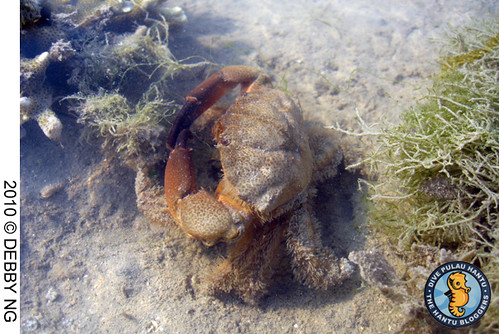 Walking down the shore into the now drained out lagoon, it doesn’t look like there is much to be been. But as soon as you stop, stoop and look, you’re able to spot all sorts of critters that are rushing to make the most of the last moments of the tide to sneak out and grab something to eat before all the water gets drained out. Here, a crab picks detris off from amongst the algae. It scuttled off quickly into a safer place right after this photo was shot.
Walking down the shore into the now drained out lagoon, it doesn’t look like there is much to be been. But as soon as you stop, stoop and look, you’re able to spot all sorts of critters that are rushing to make the most of the last moments of the tide to sneak out and grab something to eat before all the water gets drained out. Here, a crab picks detris off from amongst the algae. It scuttled off quickly into a safer place right after this photo was shot.
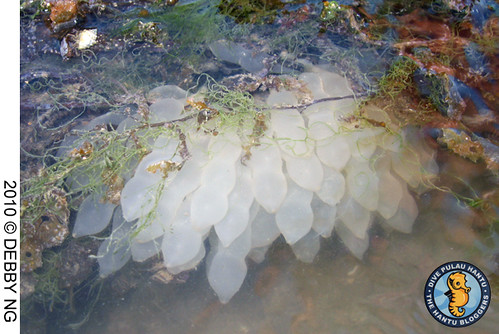
One of Dr. Dan’s students spotted this cluster of squid eggs! There was another cluster nearby. Good to know the squid are being productive! Looks like the young from this clutch have already hatched.

A young False clown anemonefish works hard to survive the low tide outside the shelter of its anemone. This little guy seemed really stressed and had just a cup full of water to sustain itself before the next high tide returned after several hours. It’s really interesting to observe the animals at low tide and see how they cope with these very challenging changes.
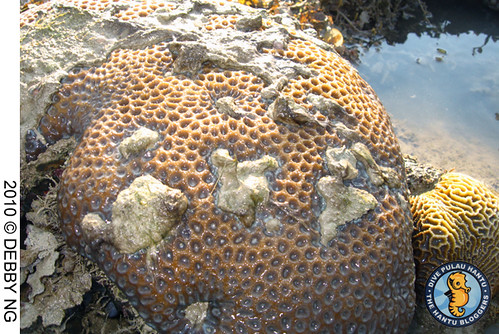
Chris came across this boulder coral, curious about the masses of mucous, algae and silt. We encounter corals with such conditions often but never really thought about what’s going on. She guesses that the coral produces the mucous as means to cope with the endless amount of silt that comes to settle on the corals in areas such as Hantu. The mucous pushes and clusters the silt and algae (foreign organisms and sediment) into recesses in and around the coral. How interesting!

While some creatures were busy feeding, and some were stressing out about the low tide, others, like the two Red swimmer crabs above, were busy trying to reproduce! See the video.
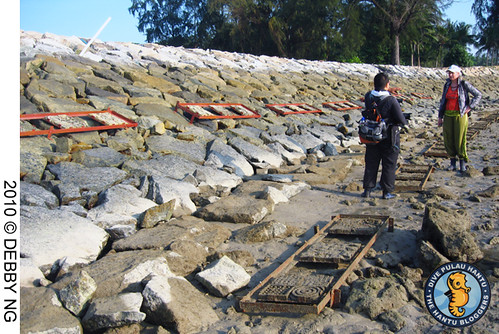
The low tide exposes the reef recruitment experimental set up anchored onto one of the sea walls and reef flats at Hantu. Read more about the experiment here.
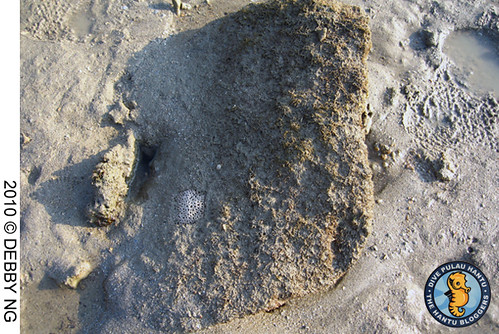
Ria and Chris noted how it was interesting to find coral recruits such as this Zebra coral Oulastrea crispata growing on the shady side of this boulder. Perhaps facing the sun makes it more challenging to survive the low tide?
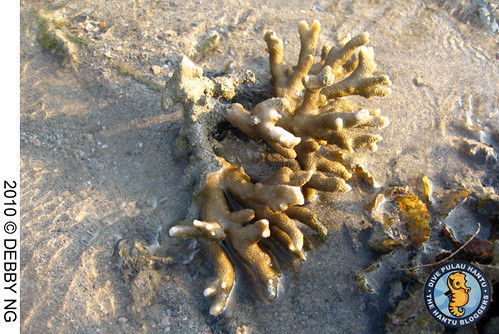
We came across this dislodged piece of branching coral and Chris commented breaking off and resettling elsewhere might be a means for corals that are growing in previous disturbed habitats to colonize more suitable areas. That’s an interesting notion! That means that just because a coral breaks off and gets dislodged, it doesn’t necessarily mean it’s doomed! So it’s best to let drifting corals lie!
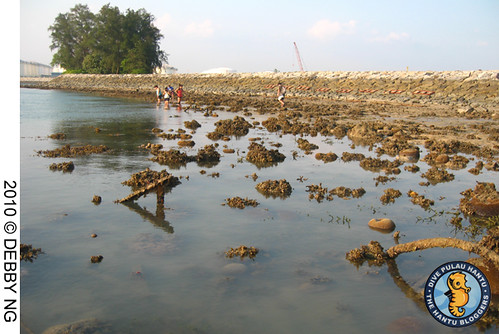
Low tide exposes the structures of earlier reef recruitment experiments conducted on Hantu’s reef. Though they appear awkward on the reef, these structures have already been colonised by a whole bunch of organisms, and fishes like the herbivorous Damselfish, and Blue-spotted fang blennies, have made homes out of them!
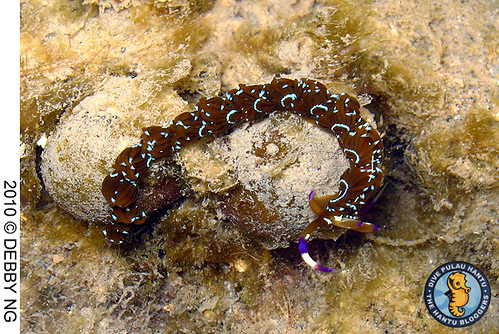
I came across this brown Blue dragon Pteraeolidia ianthina what’s really interesting is that I have never encountered this colour variation in the deeper littoral zones. Is it really a colour variation or does it appear this colour because of some other factor?

Chris decides to take a shortcut to the other lagoon by scaling the slippery, algae-encrusted seawall. The former mountain trekking guide had an unfair advantage, and ascended the wall effortlessly!

Something else I’ve not encountered on Hantu is this rather bleached looking Haddon’s carpet anemone Stichodactyla haddoni. According to Ria, this anemone is not common in our Southern shores.
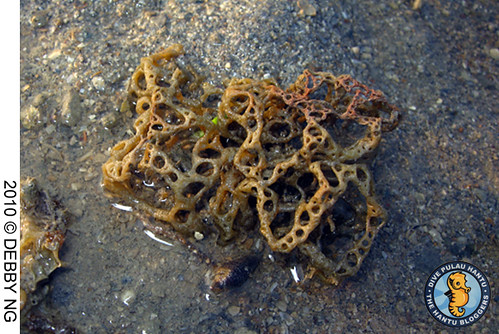
I have probably seen this before on the reef but never noticed it! It’s a strange thing and we have no idea what it is!
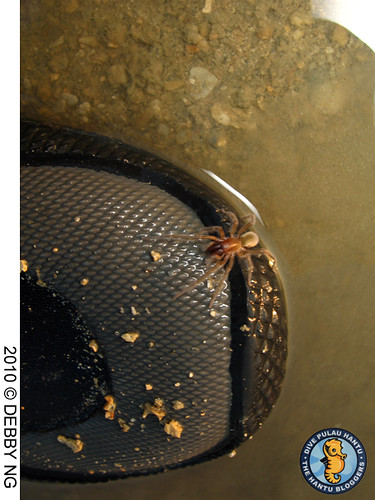
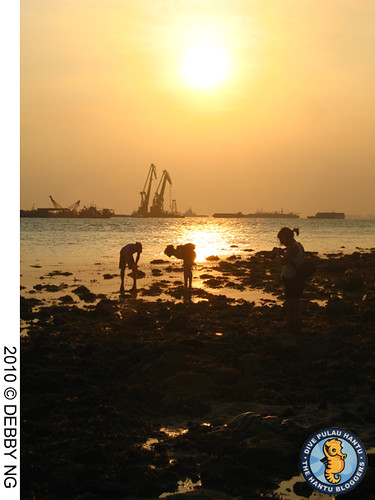
While wading across the reef, I noticed this sea spider hitching a ride on my bootie! It was probably hopping around on the water’s surface and needed a place to cling on to. As soon I brought my toe close to a rock, it swiftly hopped off and quickly ran into a nook. It’s easy to make friends on the reef! (Right) Students chase the tide and the sunlight at dusk.
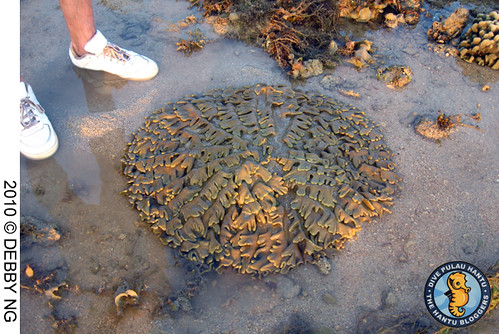
Here’s a bizarre soft coral. Bet it looks pretty awesome when it is submerged. For now it’s flopped over and desperately awaiting the return of the tide. We couldn’t figure its name out so we’re referring to it as the spiral or radial coral, because of its arrangement.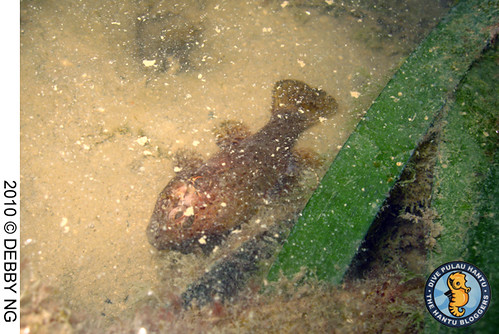
This looks like a juvenile grouper hiding in the scummy water amongst the tape seagrass. Hang in there buddy! Tide’s almost back!
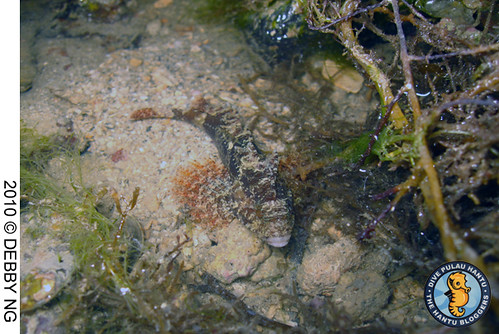
Another young fish I spotted hiding amongst the macro algae was this False scorpionfish.

Just before we headed back onto the boat, the Duke University students spotted a giant Top shell snail, and this Clear sundial snail Architectonica perspectiva! Here’s some stuff we don’t get to see often whilst diving. It’s amazing to think that even on the same reef, there’re so many things that we’re missing because we’re only looking at one little tiny zone along the entire reef!

It was an awesome day at Hantu, and one of the longest days I’ve had on the island for a long time. Completely knackered at the end of it, but refreshed in my mind by all the new discoveries I made today with Dr. Dan, Ria and Chris. All of us were treated to this amazing sunset at the end of the trip! Welcome to my office!
Read Ria’s post on the Wild Shores Blog.
See most pictures from this trip at the Hantu Blog Gallery.
 Posted in
Posted in 



 content rss
content rss
COMMENTS